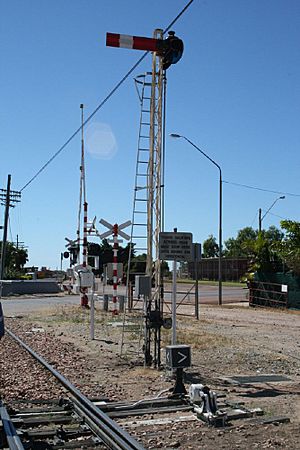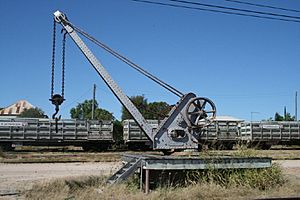Signals, Crane and Subway, Charters Towers railway station facts for kids
Quick facts for kids Signals, Crane and Subway, Charters Towers railway station |
|
|---|---|

Semaphore signal, south-west of Millchester Road, 2006
|
|
| Location | Enterprise Road, Charters Towers, Charters Towers Region, Queensland, Australia |
| Official name: Signals, Crane and Subway, Charters Towers Railway Station | |
| Type | state heritage (built) |
| Designated | 30 October 2008 |
| Reference no. | 602627 |
| Significant period | 1890s |
| Lua error in Module:Location_map at line 420: attempt to index field 'wikibase' (a nil value). | |
The Signals, Crane and Subway are important old railway parts at the Charters Towers railway station in Queensland, Australia. They show how trains were managed and how busy the station used to be. These special items were added to the Queensland Heritage Register in 2008 because they are a big part of Queensland's history.
Contents
History of the Charters Towers Railway
The Charters Towers railway station opened in 1882. It was the end point of the Great Northern railway line. This line connected the port of Townsville to the rich gold fields of Charters Towers. The gold field was first found in 1871.
Even though many of the old buildings are gone, the railway yard still has three important parts. These parts show how vital the station was. Charters Towers was Queensland's biggest and richest gold-mining town around 1900. The three important parts are:
- A rare working mechanical safety system for trains.
- An unusual pedestrian underpass from the 1890s.
- A large 10-ton crane from around 1900, which is also very rare.
Building the railway from Townsville to Charters Towers started in 1879. It opened on December 4, 1882. The railway helped Charters Towers grow. It made supplies and building materials cheaper to bring in.
Charters Towers was very successful in the 1880s. Many smaller railway lines went from the station to the gold mines. The town kept doing well even when times were tough in the 1890s. In 1899, it produced a lot of gold and had about 26,500 people. After 1899, gold mining slowly decreased. By 1916, most big mines had closed. By 1921, Charters Towers' population was much smaller, at 5,682 people.
The Charters Towers railway station used to be a very big place. In 1901, it had many buildings and tracks. These included offices, engine sheds, workshops, and many side tracks. Over time, many of these old buildings and tracks were removed.
However, some important parts still remain. These include many short side tracks and the mechanical system for controlling trains. There is also a concrete subway from 1890 for people to walk under the tracks. The station also has a large 10-ton crane. This crane is very old and was one of the heaviest used by Queensland Rail. It is a rare example of its kind.
How Railway Signals Work
Before computers controlled trains, railway signals were mechanical. They were managed from special buildings called signal cabins. These cabins controlled the trains on a certain part of the railway line. Signals told train drivers if a track was clear or if they needed to stop.
The most common mechanical signal was the semaphore signal. These had arms that moved. An arm pointing straight out meant "danger" or "do not go." These signals were usually moved by wires from the signal box. At night, lamps with colored glass showed different colors. Green meant "go," yellow meant "get ready to stop," and red meant "stop."
To make sure trains were safe, signals could be "interlocked." An interlocked yard means that signals will only let a train go if the tracks ahead are clear. A mechanical interlocking device is a system of rods and levers. It makes sure that points (tracks that switch trains) cannot be changed in a way that would cause a crash. For example, if two levers are set to "stop" for the main track, a third lever for a side track cannot be moved. This stops a train from entering the main track by mistake.
Large levers in the signal cabin allowed workers to move points, signals, or crossing gates by hand. Early systems had clever ways to connect these levers. Every interlocking system is unique to its location.
McKenzie and Holland was an early company that made railway signals in Britain. They made a new lever design in 1873 that was easier for signalmen to use. Queensland Railways bought equipment from McKenzie and Holland in 1881. Charters Towers needed a complex signal system because of its hills and the old tram tracks. This system helped prevent runaway wagons. While many stations had interlocking by 1918, this old mechanical system is now rare. Most train networks today use computer-controlled systems.
What You Can See Today
The railway station is located near Enterprise Road and Gill Street. The Charters Towers railway station today has a modern office building from the 1980s. This building and other new structures are not considered historically important. However, inside the office building is the old signal cabin. Inside the signal cabin is a very important mechanical signal frame.
The McKenzie and Holland 20-lever mechanical signal frame is a rare working example of an old railway safety system. The levers in the signal frame control an interlocking system under the floor. This system is connected to points (tracks that switch trains), points indicators, crossing lights, and signals around the station. The signalling equipment is on both sides of the Gill Street crossing. A 10-ton crane is also south-west of the crossing. These items remind us that Charters Towers was once a very busy gold-mining town.
Even though most of Queensland's railway signals are controlled by computers, the Charters Towers system still uses this old mechanical frame. It was made in Melbourne. This frame has 20 levers that control the station's points and signals. When a train comes, warning bells ring. Staff then move the levers to guide the train. The levers move the points either by long metal rods or by electric motors. The semaphore signals are controlled by wires from the frame. Electric light signals and crossing lights are also controlled from here.
A special metal key can be taken out of a lock on the signal frame. This stops the levers from moving. This key can then be used to unlock a smaller mechanical ground frame north-east of the station. This key system is very rare. The ground frame has two levers and controls access to a side track.
Here are the important parts you can see:
Signal Frame, Interlocking, and Connections
The McKenzie and Holland mechanical signal frame is in the signal cabin. It has 20 large red, blue, and black levers. Each lever has a metal tag with its number and what it does. The levers move back and forth in a curved metal frame. The words "McKenzie & Holland Melbourne" are on the frame. The interlocking system is hidden under the floor. Long metal rods run from the cabin to the points and signals. These rods connect the signal cabin to the points and the nearby semaphore signal. Wires also go to two semaphore towers south-west of Gill Street.
Points, Points Indicators, and Semaphore Towers
At the north-east end of the platform is a metal semaphore tower with a light. There is also a set of points and a points indicator. The points indicator is a lamp in a red and white box. Wires and a chain connected to the points move the semaphore arm. Further north-east are two more sets of points. These are controlled by electric motors from the signal cabin. South-west of Gill Street are three sets of points that can reset themselves. There are also three points indicators (black boxes with white arrows) and two semaphore towers controlled by cables.
Electric Light Signals
There are two signal poles north-east of the platform. They used to have signal arms and kerosene lamps. Now, they show electric lights. The lights at the railway crossing are also controlled from the signal frame.
Ground Frames
North-east of the platform is a mechanical ground frame with two large levers. This frame controls two points for a dead-end side track. The southernmost point is connected to a points indicator. This indicator has a spinning red disk and a lamp.
Pedestrian Underpass
Just south-west of the station building, but north of Gill Street, is a concrete pedestrian underpass from 1890. Stairs go down at each end to a round tunnel. Concrete walls mark both entrances.
Crane
A large metal crane from around 1900 stands on a concrete base. It is south-west of Gill Street, south of the main railway lines. It has a small wooden platform around it. A metal plate on the crane says "To Lift 10 tons."
Why These Items Are Important
The Signals, Crane and Subway at Charters Towers railway station were added to the Queensland Heritage Register in 2008. They are important for several reasons:
They show how Queensland's history changed. The mechanical signal frame and its parts show how railway safety systems developed in Queensland. The hand-operated ground frame and signals are also good examples of old mechanical signalling. This system shows how big and complex the Charters Towers railway station used to be. The many side tracks needed these signals because of all the mining and business in Charters Towers in the late 1800s. The pedestrian underpass, which you usually see at big city stations, also shows how busy Charters Towers railway station was when it was Queensland's richest gold-mining town.
They are rare or uncommon parts of Queensland's history. The signalling equipment at Charters Towers railway station is a rare example of a working mechanical railway safety system. The 10-ton crane from around 1900 is also a rare example of a large crane used by Queensland Railways. The concrete pedestrian tunnel is an uncommon example from the 1800s.
They show the main features of their type of place. The interlocked signalling system is a great example of how train safety was managed before computers took over. Every part of the system, from the signal frame's levers to its connections to the points and signals, shows how early signal technology worked. This interlocking system allowed people to control signals safely. It also prevented crashes caused by human mistakes.


